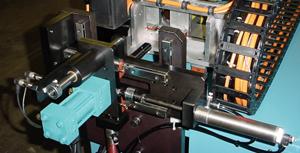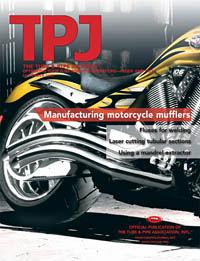- FMA
- The Fabricator
- FABTECH
- Canadian Metalworking
Categories
- Additive Manufacturing
- Aluminum Welding
- Arc Welding
- Assembly and Joining
- Automation and Robotics
- Bending and Forming
- Consumables
- Cutting and Weld Prep
- Electric Vehicles
- En Español
- Finishing
- Hydroforming
- Laser Cutting
- Laser Welding
- Machining
- Manufacturing Software
- Materials Handling
- Metals/Materials
- Oxyfuel Cutting
- Plasma Cutting
- Power Tools
- Punching and Other Holemaking
- Roll Forming
- Safety
- Sawing
- Shearing
- Shop Management
- Testing and Measuring
- Tube and Pipe Fabrication
- Tube and Pipe Production
- Waterjet Cutting
Industry Directory
Webcasts
Podcasts
FAB 40
Advertise
Subscribe
Account Login
Search
Shaping profits with a mandrel extractor
The basics of mandrel extractors and their applications
- September 1, 2009
- Article
- Tube and Pipe Fabrication
Bending a tube and preventing it from collapsing is a mystery to most folks, especially those whose livelihood does not involve bending tubes. For those who bend tubing for a living, knowing how to decrease ovality in the bend region can be of interest.
Before discussing strategies for reducing ovality, it should be noted that some tubes do not need to be round through the bent cross section; depending on the application, some ovality is acceptable. For example, shopping cart frames don't need nice round profiles through the bend zone. On the other hand, high-end furniture, medical carts, and aerospace fuel lines need minimum deformation in the bend zone.
A mandrel is a tool used on a tube bending machine to support the inside of a tube in the bend zone while the bend is being formed (see Figure 1).However, the mandrel used is only as good as the mandrel extractor assembly and the control system that supports it. It is the job of a mandrel extractor to thrust the mandrel forward into the bend zone and then, at the right moment, retract it. A slight mis-timing can cause extensive damage.
Types of Extractors
One of the basic types of mandrel extractors is actuated by a mechanical linkage powered by an operator's foot. This type of extractor can be found on a small-diameter tube bender. One advantage of this type of extractor is the initial cost; it is inexpensive because it has no electric motor for extracting the mandrel.
The next step up from a mechanical linkage is an extractor that is hy-draulic/manual. The operator activates the hydraulic pump manually to build the hydraulic pressure necessary to power the extractor. The advantage of this system is that it can extract mandrels from larger-diameter tubes than the mechanical extractor can.
The balance of the mandrel extractors found on modern tube bending machines are most often integrated into the machine's controller.
A pneumatic extractor is a good choice for small-diameter tubing. This is an environmentally friendly piece of equipment, but the typical shop air (80 pounds per square inch [PSI]) found in most fabrication shops isn't enough to handle large diameters.
More common on modern tube bending machines is a hydraulic extractor. With the right hydraulic cylinder size, a hydraulic mandrel extractor is an efficient way to extract the mandrel. While a pneumatic extractor is limited in capacity, a hydraulic extractor has no such limit.
A chief characteristic of hydraulic extractors is that they don't hesitate when they receive the command to retract. Some pneumatic extractors delay before the mandrel starts to retract from the bend zone, which leads to a longer cycle time. Even if the delay is short, it can add up over a year, a month, or even a week.
Another type of extractor uses an electric servo drive. Greener than a hydraulic extractor, an electric servo extractor can work to shave the cycle time from the overall bending process. Electric servo extractors aren't as limited in capacity as pneumatic extractors are; the drawback concerns the costs, both the initial investment and replacement parts. It is never fun to purchase a configured servo drive from the original machine tool builder when the bender is down.
Mandrel extractors are as varied as tube bender tooling itself. Variants include extractors for nonround tubing, multistack vertical positioning, and those that position a mandrel in more than two horizontal locations. Instead of having just two positions (inserted and retracted), some tube loaders require that the mandrel start in one location (before the bend starts); move to a second location to support the tube during the bending process; and retract to a third location after the bend is finished.
Controlling a Mandrel Extractor on a CNC Tube Bender
The goal of the machine's controller is to get the mandrel into and out of the bend zone at the right time in the bending process. For the most part, this is not too difficult. A mandrel extractor typically pushes the mandrel into a bend zone before the clamp closes. Then, after a bend is finished, the mandrel extractor pulls the mandrel out of the bend zone before the clamp and pressure dies open. It is most important for the machine's controller to confirm that the mandrel is extracted from the bend zone before the clamp and pressure dies open (see Figure 2).
In some tube bending applications, the extractor must retract the mandrel from the bend zone before the bend is complete. When the bend is formed at 120 degrees per second, the machine's controller must be able to react quickly to retract the mandrel consistently from bend to bend, part to part. This technique is known as early mandrel extraction. High-end tube bending controls usually allow for this feature through the operator interface (see Figure 3).
Alternatives to a Mandrel Extractor
Some mandrels don't need to be extracted. For example, some bending applications use a low-melting-point alloy for the mandrel. The operator heats the alloy, pours it into the tube, and allows it to cool before bending the tube. After making the bend, the operator heats the tube and pours the mandrel out.
Another approach is pinch-roller tooling. Pinch rollers are designed to control the ovality of a tube in the bend zone and do not require a mandrel.
About the Publication
Related Companies
subscribe now

The Tube and Pipe Journal became the first magazine dedicated to serving the metal tube and pipe industry in 1990. Today, it remains the only North American publication devoted to this industry, and it has become the most trusted source of information for tube and pipe professionals.
start your free subscription- Stay connected from anywhere

Easily access valuable industry resources now with full access to the digital edition of The Fabricator.

Easily access valuable industry resources now with full access to the digital edition of The Welder.

Easily access valuable industry resources now with full access to the digital edition of The Tube and Pipe Journal.
- Podcasting
- Podcast:
- The Fabricator Podcast
- Published:
- 04/16/2024
- Running Time:
- 63:29
In this episode of The Fabricator Podcast, Caleb Chamberlain, co-founder and CEO of OSH Cut, discusses his company’s...
- Trending Articles
Team Industries names director of advanced technology and manufacturing

Orbital tube welding webinar to be held April 23

Chain hoist offers 60-ft. remote control range

Push-feeding saw station cuts nonferrous metals

Corrosion-inhibiting coating can be peeled off after use

- Industry Events
16th Annual Safety Conference
- April 30 - May 1, 2024
- Elgin,
Pipe and Tube Conference
- May 21 - 22, 2024
- Omaha, NE
World-Class Roll Forming Workshop
- June 5 - 6, 2024
- Louisville, KY
Advanced Laser Application Workshop
- June 25 - 27, 2024
- Novi, MI



























